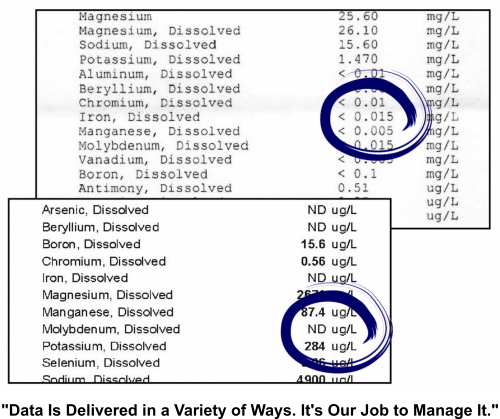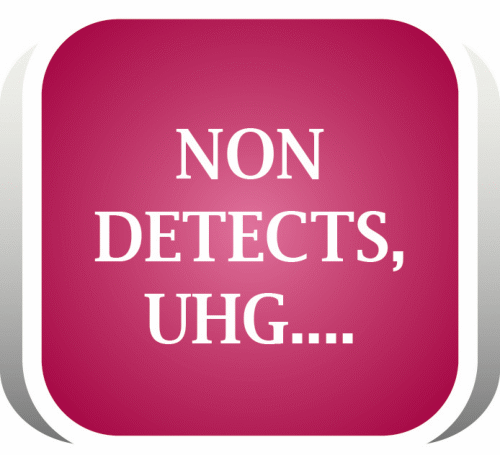
ACCOUNTING FOR NONDETECTS AND DIFFICULT RESULTS IN ENVIRONMENTAL DATA: PART 2:
Managing Non-Detects and Difficult Data in Summary Statistics, Plots and Trend Data
Analytical laboratory data frequently result in values reported only as "Non-Detect" which are measurements less than several laboratory reporting limits (less-thans, nondetects, or other qualified values).
Managing Non-Detect data are rarely taught in classes on environmental statistics nor do most regulatory standards give direction about Non-Detect data management because the methods for managing Non-Detect and other difficult data are largely dependent on the data set and their application.
Instructor Kirk Cameron, PhD, the Primary author of EPA's Unified Guidance for the statistical analysis of groundwater monitoring data, will introduce methods for managing Non-Detect and other difficult data for statistical analysis. 
Non-detects are sometimes called the 'bug-a-boo' of environmental data analysis. Ask yourself:
- How does one properly handle and account for these uncertain measurements, known to statisticians as 'left-censored' observations?
- Should they be combined with detected values?
- Is 'simple substitution' a valid statistical treatment?
- How do non-detects impact common statistical estimates and tests, such as prediction limits, confidence intervals, or trend tests?
- What are the best strategies for dealing with frequent non-detects?
- How can statistical treatment of non-detects affect site or regulatory decisions? (and we all know they do!)
|

|
This two-part webinar will tackle these questions and more, as well as provide practical, relevant examples of proper non-detect handling.
Webinar Series Highlights:
- What are non-detects really? And what is the 'ranking' problem?
- Is simple substitution ever OK?
- Key methods for handling non-detects in environmental data and their differences
- Adjusting for non-detects in summary statistics, prediction and tolerance limits, confidence intervals, and trend tests
Technical Benefits:
- Learn when to use each major non-detect adjustment method and why
- Learn how to correctly test for trends with non-detects
- Discover when to use the non-parametric Kaplan-Meier method to correctly estimate parametric confidence, prediction, and tolerance intervals
- Learn how to deal with 'dilution outliers', i.e., non-detects with very high reporting limits
- Get up to speed on EPA's recommended Double Quantification Rule for chemical parameters that are always non-detect
|
In Part 1 of this webinar, we will discuss the basic types of non-detects, common statistical models used to treat them, evaluate common non-detect strategies and guidance including simple substitution, and look at how key statistical methods have been applied to non-detects in environmental data.
In Part 2, we will delve into strategies for properly adjusting for non-detects in summary statistics and plots, in confidence, prediction, and tolerance intervals, and in trend tests such as the Mann-Kendall and linear regression.
|

|
| Fee: |
249.00 USD for Part Two,
Per Computer Site (unlimited participants per site), or
149.50 USD Each for Both Parts,
Per Computer Site (unlimited participants per site)
when Members also register for the following Webinar:

(discount will be applied during checkout when both are in your cart)
Pay one site registration fee and an unlimited number of participants from your organization can attend at that site.
|
| Instructor: |
Kirk M. Cameron, Ph.D. |
|
| Handouts: |
Copy of Webinar Slides (pdf)
Record of Attendance Form (pdf)
|
| Duration: |
1.0 hour plus Q&A
(no restrictions on time limit for extra Q&A!)
|
Professional
Development: |
Earn 1.0 Professional Development Hours (1.0 PDH)
 |
A Record of Attendance Form is included free with each webinar for your record keeping and individual PDH verification. We ask your on-site coordinator to return the completed and signed copy of the Form to us following the webinar for (1) maintaining a separate copy as a service to attendees and (2) forwarding to NIU confirming attendance for those who order certificates.
Attendees may also order an official a Course Completion Certificate from Northern Illinois University for a small administrative fee. The Certificate is optional and may be ordered separately following the webinar to confirm your attendance and showcase the certificate on your office wall. Instructions for ordering certificates are given during the webinar.

* This webinar is eligible for the 'BUY THREE, GET THREE' discount; however ANY webinar series discount shown above cannot be combined with it.
Attendees will be invited to actively participate during this live and interactive on-line web seminar. Discussion is planned following the webinar for those who want to continue the session. Bring your questions to the webinar and present them to the instructor and other participants for exploring the best solution.
Instructors Bio
 Kirk M. Cameron, Ph.D. is the founder and president of MacStat Consulting, Ltd. in Colorado Springs, a statistical consulting firm specializing in environmental statistical applications and problem solving. Began serving as a consultant to USEPA beginning in 1990, when he worked for Science Applications International Corporation (SAIC) in Northern Virginia. Currently consulting to EPA, DoD, DoE, the US Air Force, and private environmental and medical firms. Kirk M. Cameron, Ph.D. is the founder and president of MacStat Consulting, Ltd. in Colorado Springs, a statistical consulting firm specializing in environmental statistical applications and problem solving. Began serving as a consultant to USEPA beginning in 1990, when he worked for Science Applications International Corporation (SAIC) in Northern Virginia. Currently consulting to EPA, DoD, DoE, the US Air Force, and private environmental and medical firms.
Education:
Ph.D. in Statistics, Stanford University, 1990
M.S. in Statistics, Stanford University, 1989
B.S. in Mathematics, University of Nebraska-Lincoln, 1984
Professional Recognitions:
- Primary author of EPA's 2009 Unified Guidance for the statistical analysis of groundwater monitoring data.
- Design and teach training courses on the statistical analysis of groundwater monitoring data, presented to regulators, consultants, and environmental professionals around the country. Filmed a commercial videotape training series on groundwater data analysis.
- Wrote a guidance document for EPA on the geostatistical analysis of soils data. Emphasized techniques for balancing sampling costs against uncertainty in geostatistical studies.
- Developed a publicly-available geostatistical and statistical-based software application (GTS) for the US Air Force to optimize sampling frequencies and locations at sites undergoing long-term ground-water monitoring (LTM).
- Provide expert review and analysis of groundwater monitoring programs at RCRA hazardous waste sites across the country.
No Worry GuaranteeIf you can not attend the Live event, we will send you an email with instructions on how to access the On-Demand version. You will receive this email a day-or-two after the Live Event airs and the On-Demand version is usually available within a week-or-so of the Live Event. Simply click-on the 'Register' button and check the box 'I can not attend' located next to the 'Contact Email Address'.
|
Become A Member
It's Free, It's Easy and as a
Member you'll enjoy...
- Exclusive Videos
- Special Pricing
- And Much More
|
|
Join
|
Learn More
|
Association of Environmental
& Engineering Geologists
|